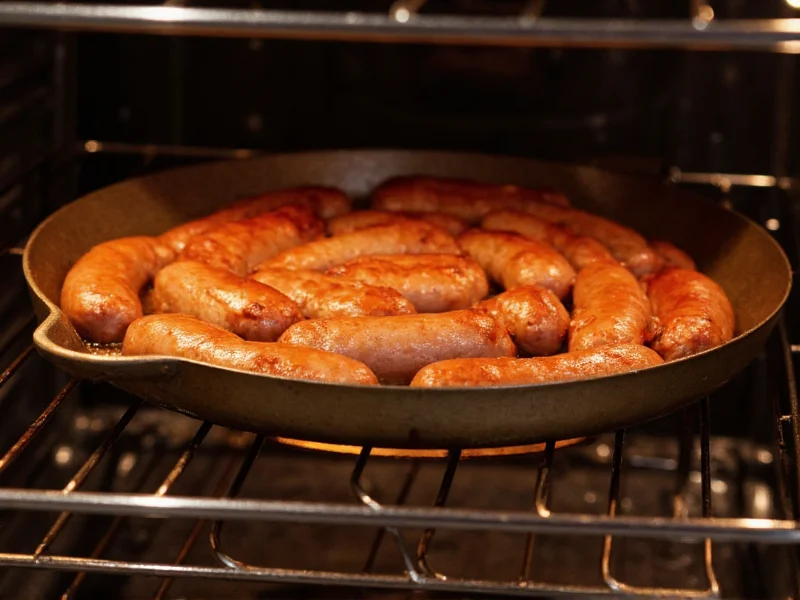For perfectly cooked breakfast sausage in the oven, preheat to 375°F (190°C), arrange sausages on a parchment-lined baking sheet with space between them, and bake for 20-25 minutes until golden brown and internal temperature reaches 160°F (71°C). Flip halfway through for even browning.
When you're looking for a hands-off method to prepare breakfast sausage that delivers consistent results without constant monitoring, oven baking proves superior to stovetop methods. Unlike pan frying which requires frequent turning and can lead to uneven cooking, the oven's ambient heat surrounds each sausage evenly, creating a perfectly crisp exterior while ensuring the interior cooks thoroughly without drying out.
Why Oven Cooking Outperforms Other Methods
Professional chefs and home cooks increasingly prefer oven-baked breakfast sausage for several compelling reasons. The dry, consistent heat of an oven eliminates the splatter mess associated with pan frying while providing more uniform cooking. You can prepare multiple sausages simultaneously without overcrowding issues that plague skillet cooking. Additionally, oven preparation allows you to set it and forget it—no need to stand over the stove monitoring temperature fluctuations.
Food safety experts emphasize that oven cooking reduces the risk of undercooked sausage, a critical concern with pork products. The controlled environment ensures sausages reach the USDA-recommended internal temperature of 160°F throughout, eliminating potential pathogens without overcooking.
Breakfast Sausage Varieties and Their Cooking Requirements
Not all breakfast sausages behave the same in the oven. Understanding these differences ensures perfect results every time:
| Sausage Type | Recommended Temperature | Cooking Time | Special Considerations |
|---|---|---|---|
| Fresh pork sausage links | 375°F (190°C) | 20-25 minutes | Flip halfway; prick skins to prevent bursting |
| Patties | 350°F (175°C) | 18-22 minutes | Thicker patties need lower temp for even cooking |
| Frozen sausage | 375°F (190°C) | 28-35 minutes | No thawing needed; add 8-10 minutes to cooking time |
| Turkey/chicken sausage | 350°F (175°C) | 22-28 minutes | Lower fat content requires careful monitoring |
Step-by-Step Oven Baking Instructions
Follow these detailed steps for restaurant-quality breakfast sausage every time:
- Preparation: Remove sausages from packaging and pat dry with paper towels. Moisture prevents proper browning.
- Preheat oven: Set to 375°F (190°C) and allow full preheating (typically 15-20 minutes).
- Prepare baking sheet: Line with parchment paper or foil for easy cleanup. For extra crispiness, use a wire rack on the baking sheet.
- Arrange sausages: Place with at least 1 inch between each to ensure proper air circulation and even cooking.
- Bake: Cook for 10 minutes, then flip sausages using tongs. Continue baking 10-15 minutes until golden brown.
- Check temperature: Insert meat thermometer into thickest part. Should read 160°F (71°C) for pork sausages.
- Rest: Let sausages sit 3-5 minutes before serving. This allows juices to redistribute.
Avoiding Common Breakfast Sausage Mistakes
Even experienced cooks make these preventable errors when baking breakfast sausage:
- Overcrowding the pan: Causes steaming instead of browning. Maintain proper spacing between sausages.
- Skipping the flip: Results in uneven browning. Flip halfway through cooking time for symmetrical results.
- Incorrect temperature: Too high causes burnt exterior with raw interior; too low creates greasy texture.
- Not checking internal temperature: Visual cues alone don't guarantee food safety. Always verify with thermometer.
- Opening oven frequently: Each time you open the oven, temperature drops 25-50°F, extending cooking time.
Maximizing Flavor and Texture
Elevate your oven-baked breakfast sausage with these professional techniques:
For enhanced browning, lightly brush sausages with olive oil before baking. Add flavor complexity by placing aromatic vegetables like onions, garlic, and bell peppers around the sausages on the baking sheet. The vegetables absorb sausage drippings while releasing complementary flavors.
When cooking frozen breakfast sausage in oven, increase baking time by 8-10 minutes but maintain the same temperature. Never thaw sausages before baking as this creates excess moisture that hinders browning.
For perfectly shaped links, prick each sausage 2-3 times with a fork before baking. This prevents bursting while allowing fat to render properly. Avoid piercing patties as this causes juice loss.
Serving and Storage Recommendations
Serve oven-baked breakfast sausage immediately for optimal texture. Pair with classic breakfast items like scrambled eggs, toast, and fresh fruit. For brunch gatherings, keep cooked sausages warm in a 200°F (95°C) oven for up to 30 minutes without quality loss.
Store leftovers in an airtight container in the refrigerator for 3-4 days. Reheat in a 325°F (165°C) oven for 8-10 minutes rather than microwaving to maintain texture. For longer storage, freeze cooked sausages for up to 3 months.
Perfecting Your Oven-Baked Breakfast Sausage Technique
Mastering how to cook breakfast sausage in oven requires attention to detail but delivers consistently excellent results. The precise temperature control eliminates the guesswork of stovetop cooking while freeing you to prepare other breakfast components. Whether you're cooking fresh or frozen breakfast sausage, following these evidence-based methods ensures safe, delicious results every time.











 浙公网安备
33010002000092号
浙公网安备
33010002000092号 浙B2-20120091-4
浙B2-20120091-4